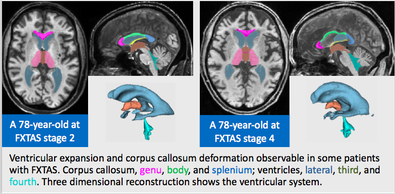Research Projects on the fragile X Spectrum of Involvement
Visual Processing and Later Cognitive Effects in Infants with fragile X Syndrome (FXS Baby Study)
In collaboration with the M.I.N.D. Institute’s fragile X Research and Treatment Center, we are currently conducting a longitudinal study of the development of visual and cognitive processing in infants with fragile X syndrome. The study includes infants with fragile X syndrome 6-72-months-old, typically developing infants between 6-48-months-old and infants with Down syndrome between 10-48-months-old. During the study we use eye tracking technology to observe the infant's looking patterns to various visual displays presented on a screen as well as complete standardized assessments of the infant's development. The information gained from this research can be utilized in future studies of early interventions using behavioral, medical and education-based treatments.
* This study is no longer recruiting.

TRAX: Longitudinal Study of Brain and Cognition in fragile X Premutation Carriers

Carriers of the fragile X permutation have been shown to exhibit mild cognitive impairment and have an increased risk of psychiatric disorders. Fruthermore, they are at risk for a neurodegenerative disease, fragile-X-associated tremor ataxia syndrome (FXTAS), characterized by neurological manifestations of progressive gait ataxia, intention tremor, Parkinsonism, dementia, autonomic dysfunction, and peripheral neuropathy. The hypothesized molecular genetic pathogenic mechanism is toxic gain-of-function of fragile X mental retardation 1 (FMR1) mRNA. The disease has a variable and age-related penetrance, affecting 75% of male premutation carriers by the eighth decade of life.
We have demonstrated that abnormal elevation of FMR1 mRNA is associated with reduced hippocampus, amygdala, and frontal lobe function, which in turn are correlated with psychological symptoms and social deficits, impaired memory recall and working memory in male premutation carriers at risk for FXTAS. Our other studies have shown brain white matter deterioration with age, reduced brain stem and increased ventricular volume, and high rates of mood and anxiety disorders in adult carriers without FXTAS compared to controls with normal FMR1 alleles.
For the current project, we plan to examine the trajectory of key neuropsychological and neurological factors in adult male carriers of the FMR1 premutation using a longitudinal design. This will allow for comparisons of progression among our current cohort, as well as among a newly enrolled older cohort approaching the median age of FXTAS symptom onset.
Brain structural changes associated with FXTAS development and progression

We utilize various magnetic resonance imaging (MRI) techniques to study the range of brain structural changes associated with FXTAS development and progression. Our long-term goal is to decipher pathophysiologic mechanisms underlying FXTAS, which is critical for developing effective treatments and generating relevant biomarkers for diagnosis and prognosis. MRI is the only method that allows non-invasive in vivo examination of the brain. Patients with FXTAS may have severe brain atrophy that makes the segmentation of the brain challenging.
We improve segmentation accuracy by using multi-atlas-based automated segmentation plus machine learning-based error correction. This step is critical for obtaining accurate measurements from various types of MRI scans. The range of brain structural changes we are studying include atrophy, morphological change (such as thinning), white matter hyper-intensities structural connectivity loss, and iron depositions in the brain. We are also conducting postmortem MRI-neuropathology association studies to understand pathophysiology underlying MRI signal changes in patients with FXTAS.
* This study is currently recruiting. If you are interested in participating, please contact us here.
